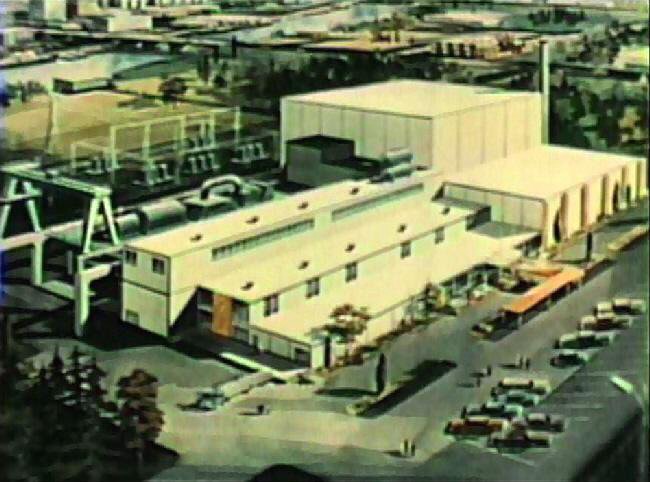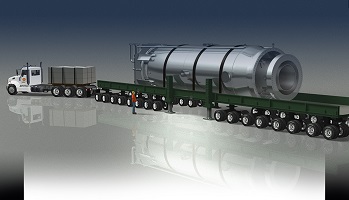Innovation and Advancement Headline ANS Annual Meeting

A hopeful nuclear industry is once again considering many advanced designs - a throwback to the 1950's and 1960's. Shown, proposed 100 MWe organic cooled nuclear plant proposed by Atomics International in the 1960's. Illustration from Will Davis collection.
The spirit of hope, even in the face of what ANS President Andy Klein acknowledges as "tough times" for nuclear energy, has made itself more than evident at the 2017 Annual Meeting. The spirit can be found everywhere, and it was further promoted on Monday morning as a new style of presentation for the opening plenary -- itself innovative -- was delivered to an excited audience.
Meeting General Chair Jose Reyes (of NuScale Power and Small Modular Reactor fame) decided to follow the keynote address with a number of rapid-fire, short, concise presentations pointed at a variety of areas in which innovation could help nuclear technology. The timing was more than appropriate as it followed Klein's first public announcement of the ANS Grand Challenges.
According to Reyes' opening remarks "innovation in a heavily regulated industry such as ours is challenging -- but it is not impossible." Reyes noted past work, considered innovative at the time, to help push the nuclear fleet's average capacity factor up into the 90% range, and also pointed out the vast work that has led to nuclear plant life extensions. Of course, Reyes added that SMR's (Small Modular Reactors) are themselves considered innovative (and the NuScale design epitomizes that description).
Reyes reminded the crowd that plenty of "young blood" now has skin in the nuclear game; he said "there are roughly 55 nuclear startups going right now, which have a total of about $1.6 billion in private sector funding and it's a truly remarkable thing that private venture capital sees nuclear energy as an opportunity." He added that the industry has not seen such a wide variety of advanced nuclear designs proposed" since the early 50s and 60s."

NuScale Power is participating in a number of significantly innovative processes - extending from the basic "power module" concept all the way through to Instrumentation and Control. Illustration courtesy NuScale Power.
The rapid-fire (ten minutes each or less) portion of the session saw nine experts in specific fields step up and describe innovations in their particular areas of expertise that are expected to, or could, if fully explored, help nuclear energy. We'll present just a few to give a sense of their nature.
Jeremy Busby (Oak Ridge National Laboratory) started off by pointing out that while the established pantheon of materials used in nuclear plants is well established, well understood, and familiar, it's also very old. The alloy of stainless steel known as 304SS, for example, is "approaching its 100th birthday," since being patented. Busby observed that with new techniques we have (and could have) more materials for use than we have now, but that an "Edisonian approach" (in which Thomas Edison tried about 3,000 materials to use as light bulb filaments before deciding on one) would take too long and cost too much. New materials must be investigated instead by new methods.
Modern material science, Busby said, can use computer modeling and simulation to develop materials from the beginning (such as new alloys, or perhaps even 3D printed materials). New methods of material analysis (ion beam, photon, and neutron) can help analyze materials in service. "We can both understand performance in service and predict future performance," he said, with advanced analytical tools. Further, "the identification of precursor states may allow for the repair, replacement or even just mitigation of damage, before failure of a part or structure," he said. "We even might be able to estimate performance under off-normal conditions," Busby added.
An interesting example of new material science was the application of 3D printing to parts, in which the texture and orientation of grains can be controlled through the many varied printed layers of the part as it is built up. Busby showed a radiograph of a part whose domains were all oriented outward at the outer edges of a printed part, an alteration to the construction of the piece intended to reduce wear. Such is not possible with casting as done conventionally -- an exciting prospect as the industry pushes for longer and longer plant lives.
Sacit Cetiner, from Oak Ridge National Laboratory, discussed I&C (Instrumentation and Control) and how alterations in this important portion of a nuclear plant might both drive down O&M (Operating and Maintenance) costs while continuing to ensure safety. Cetiner said that the "digital I&C stalemate is known to everyone here in this room," but pointed out that global trends in converting such equipment outside the nuclear industry are already decades old.
Cetiner said that O&M costs of nuclear plants is a key factor that is keeping present nuclear generation costs above that of natural gas fired plants. In fact, "O&M is a major fraction of the total generating cost," he observed. He wondered aloud if it might be possible to assist in this area by taking the bold step to not just a modernization of nuclear plant I&C but "a total transformation of I&C architecture." This change would allow for automated decision-making by computers, and would incorporate measurement of data that's not measured or tabulated today in order to facilitate this decision-making process. He added that nuclear energy "isn't the only industry ever to face an existential cost threat," but pointed out that any industry should recognize the need for action. He suggested a highly integrated, deeply-embedded I&C architecture, fault monitoring right down to the component level, predictive maintenance (rather than reactive or scheduled), and the use of risk-informed design.
Who will do this? Cetiner observed that such changes are probably too big for just one entity to undertake and pointed out that "if one single organization could do this it probably would already have been done." Multiple organizations (as well as nations' regulators) will have to be involved, he said, in order to drive this paradigm shift in operations and maintenance now to be driven by automation.
Other presenters followed, challenging the audience to think about new methods, new procedures, and even some very new and radical proposals that could cut nuclear plant costs. The appreciative audience applauded each one, and it's sure that many discussions in the hallways and restaurants have ensued centered around these innovators' talks.
 Will Davis is a member of the Board of Directors for the N/S Savannah Association, Inc. He is a consultant to the Global America Business Institute, a contributing author for Fuel Cycle Week, and he writes his own popular blog Atomic Power Review. Davis is also a consultant and writer for the American Nuclear Society, and serves on the ANS Communications Committee and the Book Publishing Committee. He is a former U.S. Navy reactor operator and served on SSBN-641, USS Simon Bolivar.
Will Davis is a member of the Board of Directors for the N/S Savannah Association, Inc. He is a consultant to the Global America Business Institute, a contributing author for Fuel Cycle Week, and he writes his own popular blog Atomic Power Review. Davis is also a consultant and writer for the American Nuclear Society, and serves on the ANS Communications Committee and the Book Publishing Committee. He is a former U.S. Navy reactor operator and served on SSBN-641, USS Simon Bolivar.

